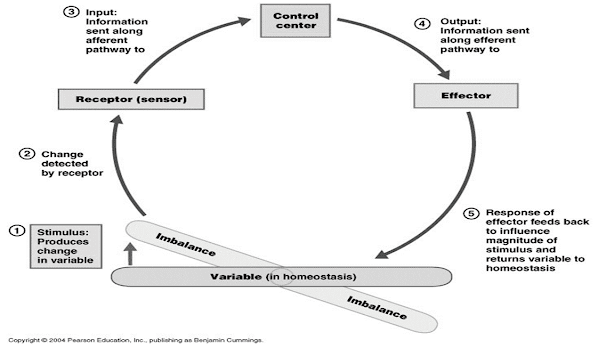Cell Injury Homeostasis

Cell Injury Homeostasis
Objectives
At the end of this lecture student will be able to –
• Describe the components of homeostasis system
• Explain mechanism involved in the internal environment maintenance
• Describe feedback loop
Understanding Cell Injury
Before we dive into the depths of homeostasis, it’s essential to understand cell injury. Cell injury refers to the damage or harm inflicted on cells, often as a result of various stressors such as infections, toxins, or physical trauma. These stressors can disrupt the normal functioning of cells and, if left unaddressed, can lead to severe health issues.
The Importance of Homeostasis
Homeostasis is the body’s way of maintaining a stable internal environment, despite external changes. It is crucial for survival and ensures that our cells can carry out their functions optimally. Two primary mechanisms govern homeostasis: positive and negative feedback.
Components Involved in Homeostasis
Homeostasis relies on three essential components:
- Receptors: These sensors detect changes in the internal environment.
- Effectors: Effectors are responsible for carrying out the necessary adjustments to counteract any deviations from the set point.
- Set Point: The set point is the ideal or target value that the internal environment aims to maintain.
HOMEOSTATIC CONTROL MECHANISMS
HOW HOMEOSTATIC CONTROL MECHANISMS WORK?
• Homeostatic control mechanisms work through ‘Feedback Mechanisms’.
• Status of a body condition is continually monitored, evaluated, changed, re-monitored & reevaluated.
FEEDBACK MECHANISM
• A feedback mechanism is a cycle in which the output of a system “feeds back” to either modify or reinforce the action taken by the system.
• A feedback mechanism may operate at:
– Tissue level
– Organ level
– Organ system level
– Body level, integrating with other organ systems.
– Feedback mechanism can be:
– Negative feedback (more common)
– Positive feedback
A FEEDBACK SYSTEM CONSISTS OF THREE COMPONENTS
- SENSOR (RECEPTOR): detects specific changes (stimuli) in the environment.
- INTEGRATOR: act to direct impulses to the place where a response can be made.
- EFFECTOR: performs the appropriate response.
A FEEDBACK LOOP
NEGATIVE FEEDBACK
• Mechanisms that maintain the factor at some mean value.
• Reverse a change
• Restore abnormal values to normal
EXAMPLE: NEGATIVE FEEDBACK BLOOD PRESSURE REGULATION
POSITIVE FEEDBACK
• Strengthens or reinforces a change.
• Makes abnormal values more abnormal.
• Produces ‘Vicious Cycle’.
• But in body a mild degree of positive feedback can be overcome by the negative feedback control mechanisms of the body, and the vicious cycle fails to develop.
POSITIVE FEEDBACK LOOP
EXAMPLE: POSITIVE FEEDBACK MEMBRANE DEPOLARISATION
POSITIVE FEEDBACKS IN BODY
• Action potential
• Clotting of blood
• Parturition
• Release of calcium from SR
• Sexual arousal
• LH surge
Impact of Cell Injury on Homeostasis
Cell injuries can disrupt the delicate balance of homeostasis. When cells are damaged or destroyed, they can no longer perform their intended functions, leading to health issues and sometimes even organ failure. This underscores the importance of maintaining cellular health to support overall well-being.
Strategies to Maintain Homeostasis
To ensure that homeostasis remains intact, individuals should adopt a healthy lifestyle. This includes a balanced diet, regular exercise, and stress management. These practices contribute to cellular well-being and help the body cope with external stressors effectively.
Conclusion
In the grand scheme of things, homeostasis is the unsung hero that keeps our body functioning smoothly. It’s a dynamic and complex process, finely tuned to handle any challenges that come its way. However, it’s important to remember that cell injury can disrupt this delicate balance, making the preservation of cellular health an essential aspect of overall well-being.
FAQs
1. What happens if homeostasis is not maintained?
- If homeostasis is not maintained, it can lead to various health issues, as the body’s internal environment becomes imbalanced. This can result in conditions such as diabetes, hypertension, and more.
2. How can I support homeostasis in my daily life?
- To support homeostasis, focus on a healthy lifestyle. This includes eating a balanced diet, staying active, managing stress, and getting enough rest.
3. Are there situations where positive feedback is harmful?
- Yes, positive feedback can be harmful in certain situations, especially when it leads to an uncontrollable amplification of a process. An example is in the case of some cardiac arrhythmias.
4. Can cell injuries be reversed?
- The extent to which cell injuries can be reversed depends on the severity of the injury. Some injuries can heal with time and appropriate care, while others may lead to permanent damage.
5. How does the body respond to extreme environmental conditions in terms of homeostasis?
- The body has various mechanisms to adapt to extreme environmental conditions. For example, in extreme cold, it may constrict blood vessels to conserve heat, while in extreme heat, it may sweat to cool down. These responses help maintain homeostasis.
Summary
• Homeostasis is involved in continuous monitoring of body’s internal environment with respect to altering external environment
• Components of homeostasis are ESI (Effector, Sensor, Integrator)
• Internal environment is maintained by positive and negative feedback mechanisms
• Most of the homeostasis mechanisms involve negative feedback














1 thought on “Cell Injury Homeostasis – B. pharma 2nd year Pathophysiology notes pdf”